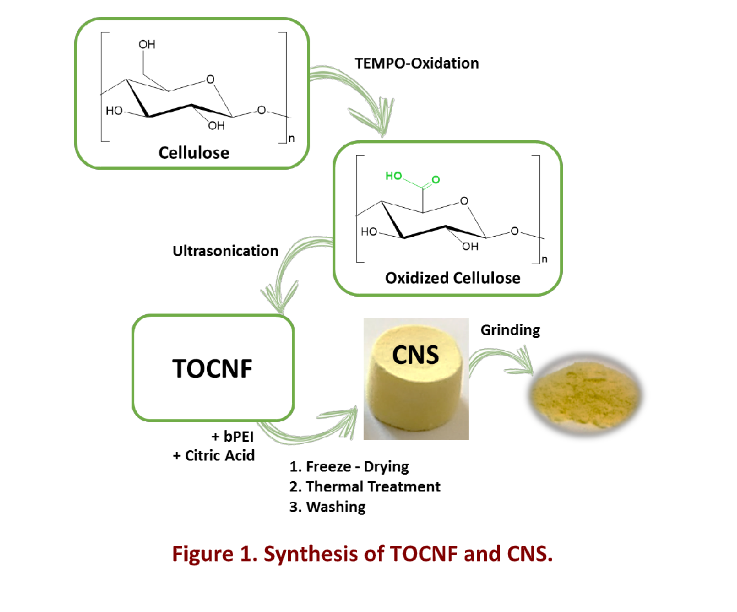Nanocellulose-based eco-safe materials for water treatment
Laura Riva, Chiara Battocchio, Alessandra Gallo, Ilaria Corsi and Carlo Punta

The growing and urgent demand for water and wastewater decontamination from a wide range of pollutants asks for the development of more effective and safer technologies. In this context, the design of manufactured nanomaterials (MNM) for an efficient water treatment is attracting more and more interest due to their promising adsorption performances. At the same time, MNM also raise concerns due to their potential (eco)toxicity and the uncertainty related to their final fate. For this reason, a safer-by design strategy is recommended in developing new MNM, which should combine a high decontamination efficiency with verified eco-safety. A first step in this route consists into the proper choice of starting material for the production of MNM.
The goal of this work is to show an overview of our recent findings on how nanocellulose, simply derived from biomass as renewable source, could represent a sustainable and eco-safe solution for developing new MNM with high sorption performances for water treatment. 2,2,6,6-Tetramethypiperidinyloxyl (TEMPO)-oxidized cellulose nanofibers (TOCNF, Fig.1), bearing carboxylic groups on the C6 position of some glucopyranose units, have been produced from different sources and their eco-safety has been verified by an in vivo acute study with marine mussels Mytilus galloprovincialis [1]. TOCNF have been successfully used both as suitable supports for silver nanoparticles (AgNPs), providing nano-composites with enhanced sorption performances towards heavy metals [2], and as building blocks for the design of nanostructured sorbent materials for water treatment, by thermal cross-linking with polyamine derivatives [3]. These cellulose-based nanosponges (CNS, Fig.1) were proven to be suitable for removing heavy metal ions from fresh- and seawater, also confirming their efficiency after several cycles of reuse. To support a non-impacting in-situ application, their eco-safety was demonstrated considering the marine microalga Dunaliella tertiolecta and the Mediterranean mussel Mytilus galloprovincialis species, toward which no genotoxic effects were observed [4]. Further studies were conducted on freshwater species, choosing Dreissena polymorpha as a model of study. In these studies, CNS turned out to be a suitable safe candidate for metal sequestering, without altering cellular physiological activity in freshwater organisms [5]. A more recent study of eco-safety assessment on CNS demonstrated that appropriate conditioning of these materials can lead to their safe use in water remediation applications [6,7].

References
- T. Rusconi, L. Riva, C. Punta, M. Solè, I. Corsi, Env. Sc. Nano 2024, 11, 61.
- L. Riva, A. Dotti, G. Iucci, I. Venditti, C. Meneghini, I. Corsi, I. Khalakhan, G. Nicastro, C. Punta, C. Battocchio, ACS Appl. Nanom. 2024, 7, 2401.
- L. Riva, N. Pastori, A. Panozzo, M. Antonelli, C. Punta, Nanomaterials 2020, 10, 1570.
- A. Fiorati, G. Grassi, A. Graziano, G. Liberatori, N. Pastori, L. Melone, L. Bonciani, L. Pontorno, C Punta, I. Corsi, J. Clean. Prod. 2020, 246, 119009.
- P. Guidi, M. Bernardeschi, M. Palumbo, V. Scarcelli, A. Fiorati, L. Riva, C. Punta, I. Corsi, G. Frenzilli, Nanomaterials 2021, 11, 2219.
- M. C. Esposito, G. L. Russo, L. Riva, C. Punta, I. Corsi, E. Tosti, A. Gallo, Env. Poll. 2023, 334, 122169.
- M. C. Esposito, G. L. Russo, L. Riva, C. Punta, I. Corsi, E. Tosti, A. Gallo, Env. Poll. 2024, in press.
Acknowledgments
This study was carried out within the RETURN Extended Partnership and received funding from the European Union Next-GenerationEU (National Recovery and Resilience Plan – NRRP, Mission 4, Component 2, Investment 1.3 – D.D. 1243 August 2, 2022, PE0000005).